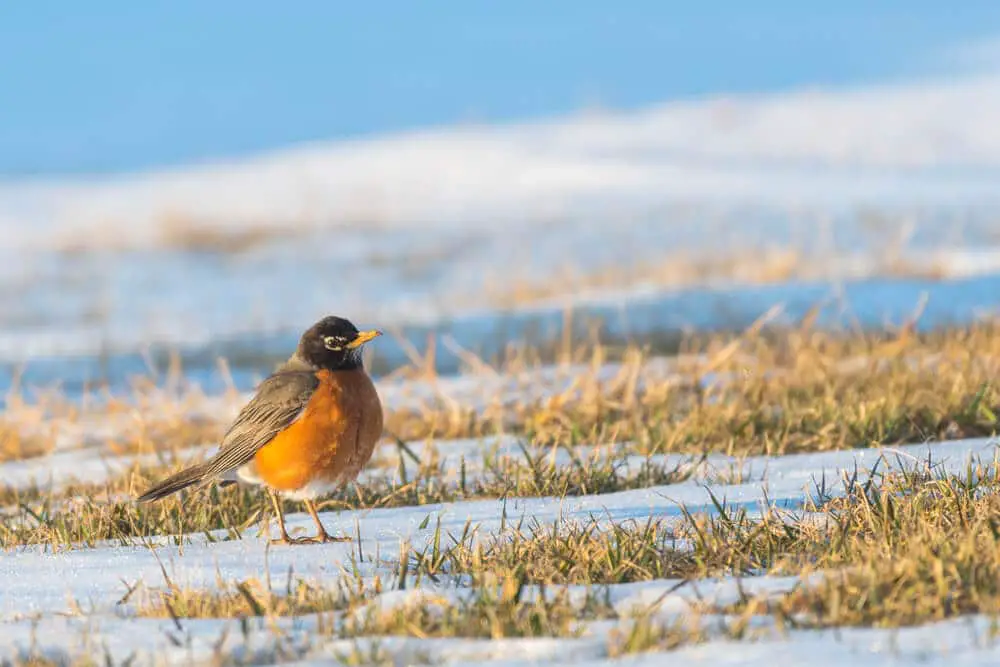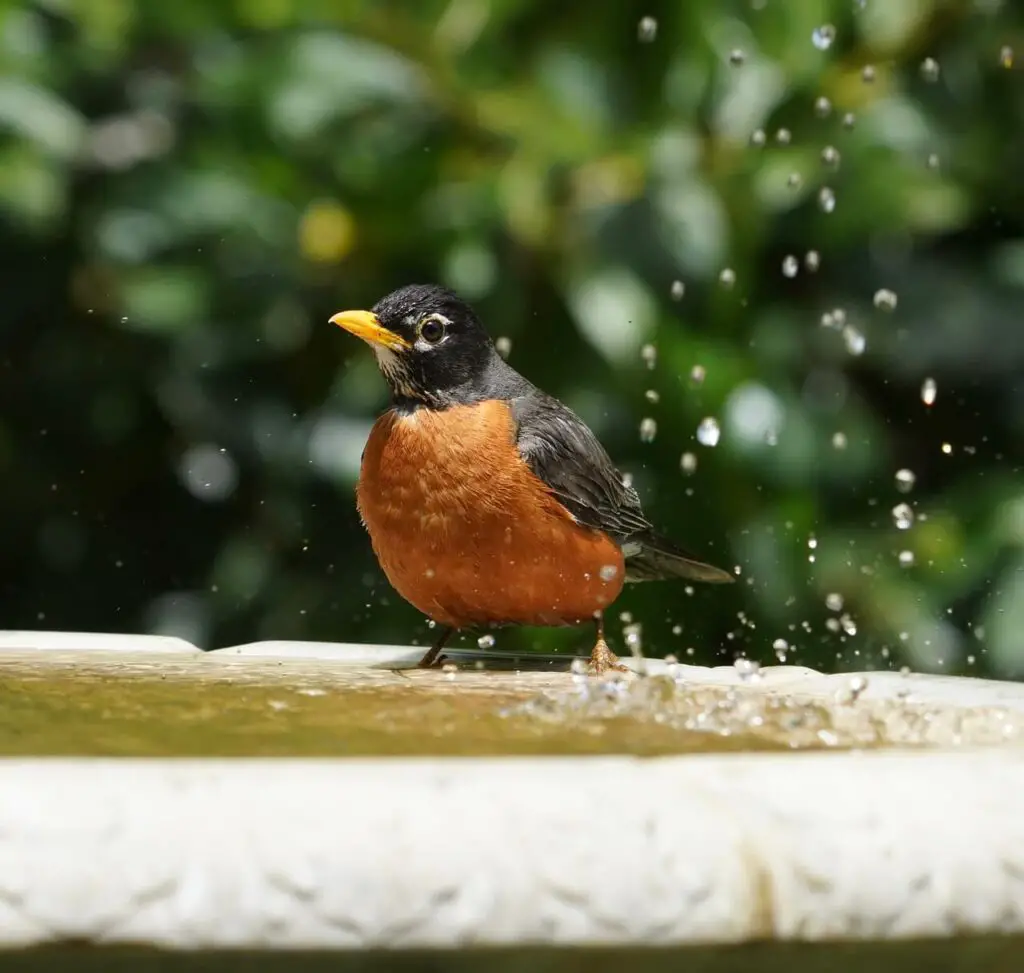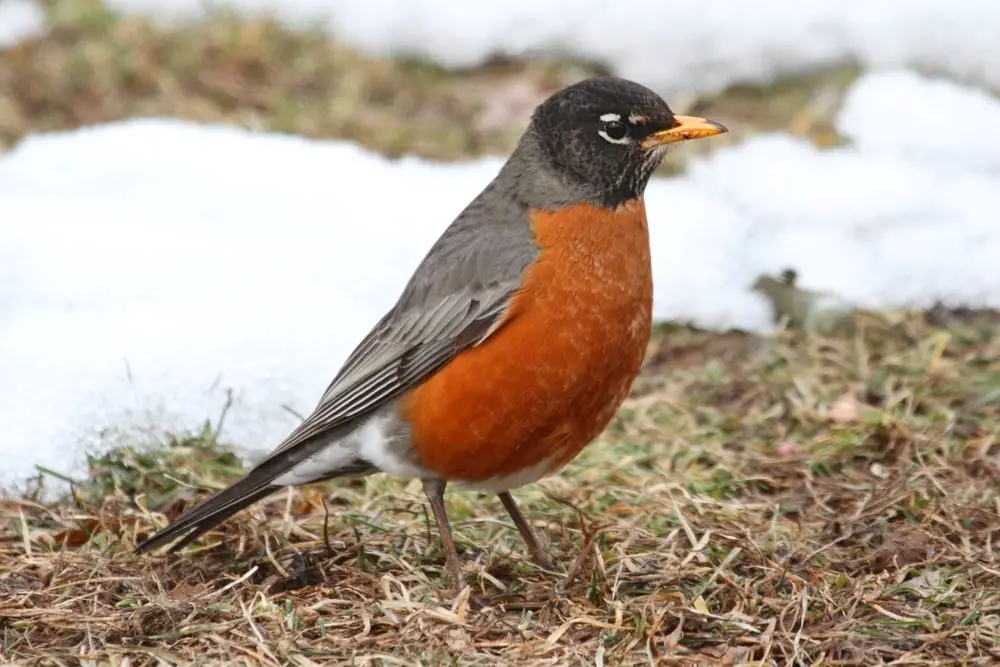It’s winter, and you are worried about the robins? Read on till the end to know what these birds eat during the winters when worms aren’t available as an easy treat and what you can feed them to help them overwinter.
What Do Robins Eat When There Is Snow On The Ground?
Robins get most of their nutrition from earthworms and other insects during the warmer months, but they switch to fruit in the colder months.
Robin colonies that overwinter rely on the invasive bush honeysuckle. During the winter in Illinois, robin populations are greater in regions with honeysuckle compared to those with native plants.
The number of non-native fruit-bearing trees and bushes has expanded considerably, and the Amur honeysuckle is now the most abundant in central Ohio. In Ohio, it ranks among the worst invaders.
During the winter, robins congregate in large groups and roam the landscape in search of the fruits of honeysuckle and other such plant species.
Occasionally, hundreds of robins would flock to raid a popular location.
Even while honeysuckle berries are simple to obtain, they are far less nutrient-dense than the fruits of native plants. Therefore, it is more challenging for robins to subsist on the little offers of honeysuckle when harsh winter weather persists for longer periods of time.
Take note that not all robins are created equal. It’s true that most robins go south during the winter. However, there are many who remain in the north and wander the region. When deciding where to go, robins are driven more by the availability of food than by the weather.
Learn more: Where Do Robins Go In Winter?
Robins rely on fruits throughout the winter. In the spring, when the ground thaws, they turn to eating earthworms.
As the winter season continues, so does the freezing temperatures. Since more and more fruit is consumed throughout the winter, robins have a greater requirement for food during this season.
When food is scarce, or the weather is severe, robins relocate.
If all robins decided to spend the winter at the same latitude where they nest, there simply would not be enough fruit.
Therefore, robins disperse in search of fruit during the winter. While most robins congregate in areas with an abundance of fruit, some brave souls choose to spend the winter in the extreme north, where only a limited supply of fruit remains.
What Can You Feed Robins When The Ground Is Frozen?

#1. Put Out Some Cranberries For Them
Small berries are a pleasant source of fast calories and carbs for insectivores like robins. If the birds are really hungry, the cranberries will be devoured in no time.
Some birds may not like the tart flavor of fresh cranberries. However, the antioxidants included in cranberries help strengthen the bird’s defense system.
In addition to copper, these berries also include antioxidants, vitamins, and other components that help maintain birds in top flying condition.
Any bird can benefit from including cranberries in its diet, even if they aren’t considered a treat.
Growing your own cranberries in the garden is the ideal option if you want to feed the robins.
One of the finest ways to aid and promote berry-eating birds in your region is to cultivate berry-producing bushes if you reside in an appropriate location with the correct sort of soil and growth conditions.
Cranberries, like strawberries, are a native American fruit that spread by vining shrubs. The vines need the unique marsh conditions of soil and water in order to flourish. The sand, gravel, and peat used in cranberry beds help the plants drain excess water.
But if growing cranberries is not a suitable option for you, then, you can also leave a couple of cranberries on a bird table for the robins.
#2. Give Them Raisins
Birds, particularly robins, like a snack of raisins. Raisins, which are just dried grapes, are a fantastic dietary supplement due to their high nutritional quality.
Robins can get a much-needed energy boost from them, especially in the winter when food is limited.
Adding raisins to a suet cake or soaking them in water and putting them on a flat feeder can help the birds digest the meal more easily.
Related Read: Can Robins Eat Mice?
#3. Serve Them Mealworms
In warm climates, American robins choose insects and other invertebrates, but in the winter, they turn to berries and fruits.
You can still make their diet more interesting by offering them something that isn’t veg – like mealworms.
Unlike hummingbird feeders, which are designed specifically for these little birds, regular bird feeders won’t attract robins (because, ultimately, they are ground feeders).
Having mealworms fall to the ground is a waste of time and effort after taking the time to put up a beautiful feeder. Avoid using feeder dishes with rounded or curved edges. Choose a straight-edged one.
Dried mealworms can be fed at any time of year, but only in little amounts. Your birds could take some time to adjust to eating dry mealworms.
But you can attract the robins to feed on them. Dried mealworms can be rehydrated by adding a little water if they are going to be left out on their own. To be safe, mealworms should not be left out for longer than two days if they are moist dry.
If one bird discovers the dried mealworms, the others won’t be long in following suit.
How To Take Care Of Robins During The Winter?

In short, here’s what you can do to help robins live through the winters:
- Provide them with fruits and other food sources on the bird table.
- Preparing a nesting shelter for robins so that they can tolerate the chilly winds of winter.
- Ensure water resources are available to them because it is scarce in the winter.
To help their avian companions stay hydrated and cool off throughout the summer, backyard birders consistently fill water dishes for them.
It’s common for people to assume that birds won’t need their birdbaths or other sources of water until the next spring, so they store them away. This is not the case, however, since water is just as vital in the winter for birds and other species as it is in the summer.
Even in cold climates where snow and ice are plentiful, robins may still have to expend energy and heat to get the water they need. Hence, enough water resources are available for them to help them out.
More birds will visit a backyard in the winter if it has a source of clean, liquid water. Birdbaths that rely on solar energy or fountains should be swapped out for more permanent fixtures before the first frost. Consider installing an immersion water heater to prevent water from freezing over.


